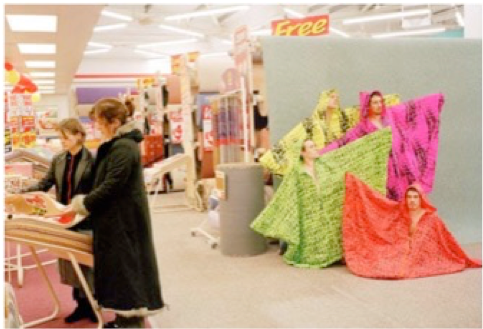
This photograph creates a frame within a frame with the artist inside but picturing the outside through the window. The window seems to be very dirty therefore creating a dull, dusty tone for the photograph giving the impression its very old. The landscape pictured is urban with the presence of buildings, cars and people. I like the composition of this image because it is not too busy with the road creating blank space before meeting the car and then the building. The image may be more interesting if the lighting allowed for a different range of colours to be seen, as it provides more for the viewer rather than just one monotone shade.

This image picture a model lying on a compost bag while wearing floral clothes, suggesting the photographer wanted to erase the boundaries and bring the outside in. the colour of the suit is almost Identical to the floor which emphasises the floral design and its relation to the compost. The lighting in the image is quite dim which contrasts with the bright blue of the compost and flowers on the shirt which again emphasises the importance of these elements. while the angle creates leading lines from the legs to face of the model forcing the viewer to look at everything in the image as it almost fills the frame.
Inside and outside can mean many different things the main being in a building and outside in the landscape, your own private space compared with a public. The inside can be seen as concrete while the outside is vast with endless possibilities however contrary to belief inside can also seem vast with details, this can be seen in Heidi Specker Travertin’s images of walls where the endless details contrast with the concrete inside. Walter Benjamin states the living room is like a box in the theatre of the world it is a domestic fantasy in comparison the outside/ place of work which is reality. However inside and outside can also refer to social groups, this is shown in Robert frank’s the Americas where he pictures the social segregation between black and white people on a bus making certain people feel like outsiders in the world. Similarly, migrants are also linked to the idea of inside and out where not all are let into a country and therefore left outside. Clothes can also divide between inside and out in terms of social groups where each wear different fashion choices as well as being a bridge between public/ people and your private body. Moreover doors and windows also bridge the inside and out, doors allow for hesitation and act as a threshold, but can be both a connector as they can be opened and allow you into the outside world or a disconnector as they can be shut and looked and stop you from entering the outside therefore allowing for both inclusion and exclusion.























